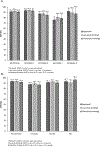Alcohol use and hepatitis C virus treatment outcomes among patients receiving direct antiviral agents
- PMID: 27810652
- PMCID: PMC6534140
- DOI: 10.1016/j.drugalcdep.2016.10.021
Alcohol use and hepatitis C virus treatment outcomes among patients receiving direct antiviral agents
Abstract
Background: It is unclear whether alcohol use negatively impacts HCV treatment outcomes in the era of direct antiviral agents (DAAs). We aimed to evaluate the associations between current levels of drinking and treatment response among persons treated for HCV with DAAs in the national Veterans Affairs (VA) healthcare system.
Methods: We identified patients who initiated HCV DAAs over 18 months (1/1/14-6/30/15) and had documented alcohol screening with the Alcohol Use Disorders Identification Test Consumption (AUDIT-C) questionnaire within one year prior to initiating therapy. DAAs included: sofosbuvir (SOF), ledipasvir/sofosbuvir (LDV/SOF) or ombitasvir-paritaprevir-ritonavir, and dasabuvir (PrOD). AUDIT-C scores were categorized as 0 (abstinence), 1-3 (low-level drinking) and 4-12 (unhealthy drinking) in men or 0, 1-2 and 3-12 in women.
Results: Among 17,487 patients who initiated DAAs, 15,151 (87%) completed AUDIT-C screening: 10,387 (68.5%) were categorized as abstinent, 3422 (22.6%) as low-level drinking and 1342 (8.9%) as unhealthy drinking. There were no significant differences in sustained virologic response (SVR) rates between abstinent (SVR 91%; 95% CI: 91-92%), low-level drinking (SVR 93%; 95% CI 92-94%) or unhealthy drinking (SVR 91%; 95% 89-92) categories in univariable analysis or in multivariable logistic regression models. However, after imputing missing SVR data, unhealthy drinkers were less likely to achieve SVR in multivariable analysis (AOR 0.75, 95% CI 0.60-0.92).
Conclusion: Absolute SVR rates were uniformly high among all persons regardless of alcohol use, with only minor differences in those who report unhealthy drinking, which supports clinical guidelines that do not recommend excluding persons with alcohol use.
Keywords: AUDIT-C; Direct antiviral agents; Hepatitis c treatment.
Published by Elsevier Ireland Ltd.
Conflict of interest statement
Conflict of interest
No conflict declared
Figures

References
-
- Anand BS, Currie S, Dieperink E, Bini EJ, Shen H, Ho SB, Wright T, 2006. Alcohol use and treatment of hepatitis C virus: results of a national multicenter study. Gastroenterology 130,1607–1616. - PubMed
-
- Armstrong GL, Wasley A, Simard EP, McQuillan GM, Kuhnert WL, Alter MJ, 2006. The prevalence of hepatitis C virus infection in the United States, 1999 through 2002. Ann. Intern. Med. 144, 705–714. - PubMed
-
- Backus LI, Boothroyd DB, Phillips BR, Mole LA, 2007. Predictors of response of US veterans to treatment for the hepatitis C virus. Hepatology 46,37–47. - PubMed
-
- Barua S, Greenwald R, Grebely J, Dore GJ, Swan T, Taylor LE, 2015. Restrictions for Medicaid reimbursement of sofosbuvir for the treatment of hepatitis C virus infection in the United States. Ann. Intern. Med. 163, 215–223. - PubMed
-
- Beste LA, loannou GN, 2015. Prevalence and treatment of chronic hepatitis C virus infection in the US Department of Veterans Affairs. Epidemiol. Rev. 37, 131–143. - PubMed
Publication types
MeSH terms
Substances
Grants and funding
LinkOut - more resources
Full Text Sources
Other Literature Sources
Medical

